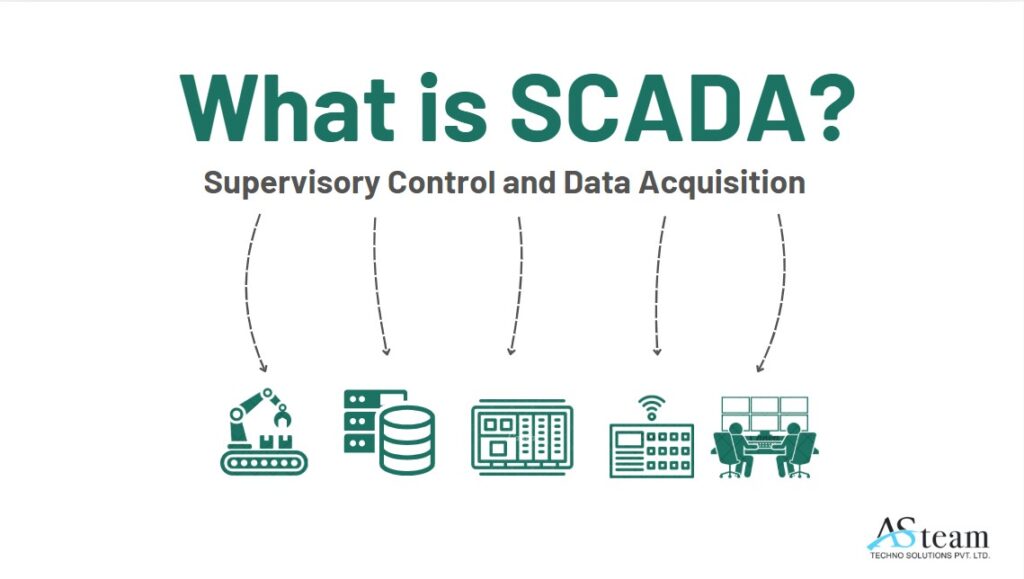What is SCADA and how does it work in modern industrial systems?
SCADA (Supervisory Control and Data Acquisition) systems are essential to contemporary industrial processes in Industry 4.0, where automation and data are crucial. These systems offer real-time monitoring and centralized control of intricate, regionally dispersed operations. SCADA increases productivity, decreases downtime, and facilitates better decision-making in a variety of industries, including manufacturing, energy, water treatment, and transportation.
What is SCADA?
SCADA is a hardware and software system that enables industrial organizations to monitor, collect, and process real-time data, control processes locally or remotely, and use human-machine interface (HMI) software to communicate directly with devices like sensors, valves, pumps, and motors.

A typical SCADA system includes:
Supervisory Computers: These servers host the SCADA software and provide a user interface.
- Remote Terminal Units (RTUs): microprocessor-driven gadgets that communicate with field sensors and actuators.
- Programmable Logic Controllers (PLCs): Industrial computers that interact with SCADA software and manage machines.
- Communication Infrastructure: networks, either wired or wireless, that allow information to go between control centers and field equipment.
- HMI (Human Machine Interface): Operators interact with the system and visualize processes via the graphical interface.
How Does SCADA Work?
- Data Acquisition: RTUs and PLCs are connected to field sensors that measure variables such as temperature, pressure, flow, and level. These devices gather real-time data from equipment like motors, valves, and switches.
- Data Transmission: The collected data is transmitted via communication protocols (such as Modbus, DNP3, or OPC) to the SCADA servers. These may use Ethernet, serial, fiber optics, or wireless communication.
- Data Processing and Visualization: The SCADA server processes the incoming data and displays it through the HMI. Operators can view trends, alarms, and live data, often using graphical representations like process diagrams or dashboards.
- Control Actions: Operators can send commands through the SCADA interface to control equipment, such as opening a valve, stopping a motor, or changing setpoints. The commands are relayed through the PLCs or RTUs to field devices.
- Data Logging and Analysis: SCADA systems store historical data for trend analysis, regulatory compliance, and predictive maintenance. This data can be used to generate reports, identify inefficiencies, and make informed operational decisions.
Modern Advancements in SCADA
- Cloud-based SCADA: Enables remote monitoring and control through web-based platforms, enhancing accessibility and scalability.
- Cybersecurity Integration: With increased connectivity, SCADA systems incorporate advanced cybersecurity measures to protect against threats.
- Mobile Access: Operators can now use mobile devices and tablets to access SCADA dashboards from anywhere.
- IoT Integration: SCADA systems now integrate with Internet of Things (IoT) devices to gain granular control and insights from smart sensors.
- Advanced Analytics and AI: Predictive analytics and machine learning can forecast equipment failures and optimize operations.
Applications of SCADA
Industrial Control
SCADA systems are commonly utilized to monitor and control production processes in manufacturing sectors such as water treatment, oil and gas, and automotive. They guarantee that equipment runs well, cut down on downtime, and raise total output.
Energy Management
SCADA systems are essential for monitoring and managing power generation, transmission, and distribution in the energy industry. They support operators in controlling power networks, maximizing energy output, and adapting to demand variations.
Water and Wastewater Management
SCADA is used in water treatment facilities for pump and valve control, distribution network management, and water quality monitoring. It effectively manages wastewater and contributes to the provision of safe and clean drinking water to communities.
Transportation and Infrastructure
SCADA optimizes traffic flow and improves safety in transportation systems including railway control and traffic management. Additionally, it finds use in the management of vital infrastructure, such as pipelines, bridges, and tunnels.
Benefits of SCADA
- Implementing a SCADA system offers numerous benefits to modern industrial operations:
- Real-time Monitoring: Operators receive immediate feedback on system performance and anomalies.
- Improved Efficiency: Automation reduces human intervention and speeds up operations.
- Reduced Downtime: Proactive maintenance and alarm management prevent unplanned outages.
- Enhanced Safety: Real-time alerts and control capabilities improve operator response to critical conditions.
- Data-Driven Decisions: Historical data and analytics help managers make strategic decisions for process optimization.
Conclusion
SCADA remains a cornerstone of modern industrial automation. By enabling real-time control, data acquisition, and process visualization, it empowers industries to achieve higher efficiency, safety, and reliability. As technology continues to evolve, SCADA systems will play an even more crucial role by integrating with digital tools, cloud computing, and smart manufacturing practices.

